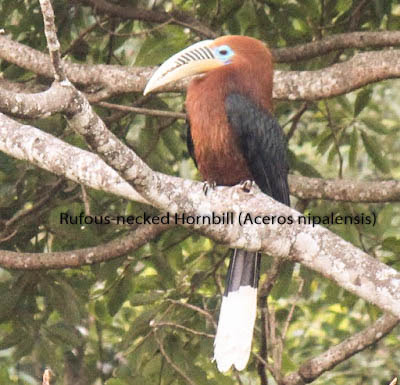The Rufous-necked hornbill is a species of hornbill found in Indian subcontinent and southeast Asia. The number of this bird species has declined significantly due to habitat loss. However, Bhutan has some countable numbers of this bird species intact.
Although, Zhemgang is
secluded from most modern touch however, the place is known for rich biodiversity. Thus, it homed to many critically endangered flora and fauna. One
among them is Rufous-necked hornbill which is already under threatened list globally.
Perhaps, it was a
wonderful experience to shoot this high–flying bird on my recent trips to
Mithun farm. Occasionally, one can also find this bird feeding on the way to
Buli, tingtibi, gonphu-pangbang highway and around Royal Manas Park in lower
Kheng.
It has been over a month
now, but I still have that great feel of this giant bird flying over my head.
This bird is very sensitive to human sound and settlement. Thus, it settles to
an amazingly uncommon place for feeding and tall tree branch for nesting making
it very difficult for a common people to see its young one.
Of the four different
species of the Hornbill found in Bhutan, Rufous-necked hornbill is found at the
highest elevation.
Rufous-necked hornbills are monogamous birds and a gender sensitive. Owing to its survival, male counterpart is brighter in color than its female partner.
This bird has a large
colorful body with large and sublime beak which they use for breaking fruit
seeds and for defensive purpose. Like most of the birds, it also got some cultural
significance or belief. It has very husky and peculiar call different from
other bird species.
The nesting season is
in-between mid-March to mid-July with breeding cycle that last for approximately
four months (120 days).
Rufous-necked hornbill
mainly faces threats from timber extraction, collection of wild fruits and
seeds, road constructions, hydro power project, clearing of forests for power
transmission line and natural threats such as competition for food. This bird is
also found to be extremely vulnerable to serpent eagle attack.
The way forward to
preserve this bird is by incorporating hornbill conservation activities in the
community and by initiating environmental education outreach programmes to
school children and local community.
Over five years of bird
watching and photographing experience, and having travelled to great length of
forest, I have learned that there is nothing like enjoying with nature. It also helps one to manage stress and relief from unnecessary tension. It makes you
feel happy and calm your mind.




No comments:
Post a Comment